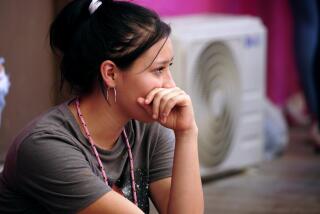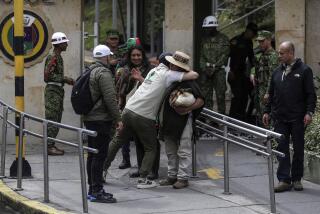Most Victims in Mexican Earthquake Who Reached Hospitals Survived
- Share via
MEXICO CITY — The last survivor pulled from the wreckage of Mexico City’s earthquake likes his milk warmed and his feet tickled.
His name is Jose Medina Hernandez; he is now 28 days old, and he spent more than eight of them trapped beneath collapsed debris of the pediatric ward of Mexico City’s General Hospital.
Since Jose’s rescue just after midnight Sept. 28, no one has been found alive in the ruins of the shattering earthquake of Sept. 19 and the fierce aftershock the next day. The baby, still a little pale and underweight, is recuperating at the Mexico Children’s Hospital here. He is among several hundred lucky survivors of fallen buildings.
Pattern of Hope
Jose is an example of an apparent pattern in the rescue process here: If a victim arrived alive at a hospital, there was a good chance that he would survive.
No reliable figures exist for the total number of rescues. Many patients were shuttled from hospital to hospital, and statistics of earthquake victims have been mixed with numbers of patients who were merely transferred from hospitals that were damaged by the quakes but who themselves suffered no quake-related injuries.
A survey of several Mexico City hospitals that treated victims showed that in some cases, more than 90% of the injured patients who were admitted survived.
At the 20th of November Social Security Hospital, 234 patients suffering a variety of injuries were admitted in the days after the quake. Of those, 20 died. All but nine of the rest have now been released.
Fifty-nine adult earthquake victims entered the Military Hospital, and of those, six died, Gen. Carlos Gomez del Campo, that hospital’s director, said. In addition, of four newborn babies taken to the Military Hospital for treatment, one, a girl, died of severe infection.
Most Children Do Well
Fifty-five children ranging in age from a few days to 15 years entered the Mexico Children’s Hospital with wounds. Some of those were transfers from other hospitals. Sixteen were babies recovered from the collapsed General and Benito Juarez hospitals.
Of those, one died, a newborn dubbed Maria Milagros (Mary Miracles) by the staff because she had survived more than 200 hours in debris before arriving at the hospital. The infant Milagros entered the hospital Sept 27 and died Sept. 30 of extensive infections.
A 10-year old boy also died at Children’s Hospital, of shock.
The National Pediatric Institute treated 60 children for broken bones, compressed organs and muscles and a variety of wounds. None died.
The most recent figures for dead from the quake exceed 7,000.
Reasons for Survival
Survival of both adults and children seemed to depend on a variety of factors. Speed of rescue was important; victims trapped in buildings could be heard whimpering for hours after the quake, but few could be saved from the heavy rubble quickly.
Many of the victims suffered crushed limbs, but that in itself proved less deadly than if they suffered open wounds that bled.
Survival may have also depended on whether breathing or elimination of body wastes was constricted by pressure from heavy debris. In some cases even after rescue, damage to lungs and kidneys was irreversible.
The survival of the babies drew special attention from doctors because of the conditions that the infants overcame: cold, dust, lack of food, wounds in many cases.
“These were not optimal conditions for a newborn,” said Dr. Dina Villanueva, head of the infant intensive care unit at Children’s Hospital.
Several of the rescued babies suffered from dangerously reduced body temperature and dehydration as well a scrapes and bruises. A few had swallowed a lot of dust and brick particles, but without apparent damage, Villanueva said.
Advantage of Very Young
Mentally, they were perhaps better equipped than adults to survive. “They don’t think logically. They didn’t know what happened,” the doctor continued.
Immobility caused by debris or by the infants’ inability to change positions by themselves resulted in stiff joints and abnormal muscle contractions among several newborns.
Mexican doctors are closely watching the progress of babies under their care, and infants already released are being examined periodically. “This is going to change a lot of thinking about the survivability of babies,” said Guillermno Uribe, a physician at the National Pediatric Institute.
Baby Jose Medina Hernandez, besides weight loss and cuts on his forehead and the back of his neck, suffered a slightly disjointed hip from having spent so long in a twisted position. He sleeps on a specially designed pillow to correct the twist.
Unlike many of the other babies who survived, Jose did not lose his mother in the earthquake. Also injured, she has now been released from the hospital, while Jose remains for treatment of jaundice.
“The maternal contact is very important,” Villanueva said. “We don’t know how isolation might have affected the other survivors. We are trying to involve the fathers as much as possible in feeding and caring for the children.”
Mother Still in Hospital
While Jose remains in intensive care, his mother, Leonila Medina Hernandez, visits him daily, feeds him with a bottle and rocks him to sleep.
“He seems to be getting better every day,” she said. “He was so thin when he arrived.”
The boy was rescued at General Hospital by workers who had heard him cry. Before they reached him, they came upon Maria Milagros, who was taken out first.
Neurological tests so far show no brain damage to Jose.
The mothers of two other rescued babies at Children’s Hospital died during the quake and the infants will be raised by aunts.
“It will be interesting to see how they are raised,” Villanueva said. “There is a chance that some will be overprotected, with foster parents thinking that they are exceptionally fragile. Others might not receive the full care they would have if their mothers had lived. Either extreme is not good for the child.”
More to Read
Sign up for Essential California
The most important California stories and recommendations in your inbox every morning.
You may occasionally receive promotional content from the Los Angeles Times.












